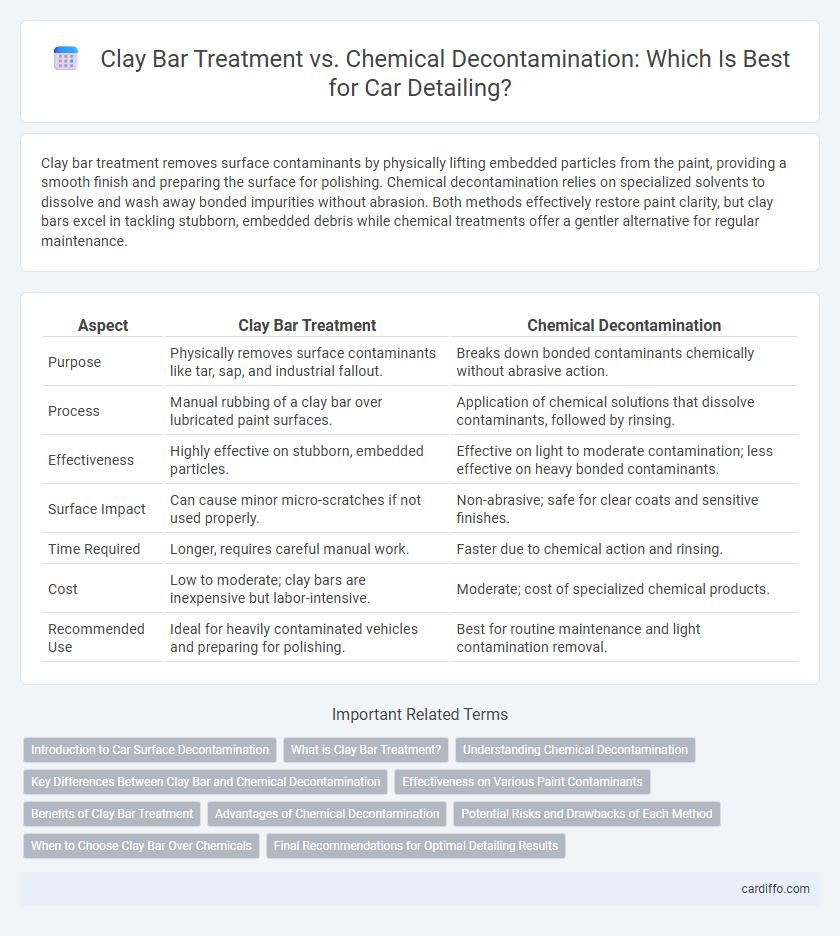Clay bar treatment removes surface contaminants by physically lifting embedded particles from the paint, providing a smooth finish and preparing the surface for polishing. Chemical decontamination relies on specialized solvents to dissolve and wash away bonded impurities without abrasion. Both methods effectively restore paint clarity, but clay bars excel in tackling stubborn, embedded debris while chemical treatments offer a gentler alternative for regular maintenance.
Table of Comparison
| Aspect | Clay Bar Treatment | Chemical Decontamination |
|---|---|---|
| Purpose | Physically removes surface contaminants like tar, sap, and industrial fallout. | Breaks down bonded contaminants chemically without abrasive action. |
| Process | Manual rubbing of a clay bar over lubricated paint surfaces. | Application of chemical solutions that dissolve contaminants, followed by rinsing. |
| Effectiveness | Highly effective on stubborn, embedded particles. | Effective on light to moderate contamination; less effective on heavy bonded contaminants. |
| Surface Impact | Can cause minor micro-scratches if not used properly. | Non-abrasive; safe for clear coats and sensitive finishes. |
| Time Required | Longer, requires careful manual work. | Faster due to chemical action and rinsing. |
| Cost | Low to moderate; clay bars are inexpensive but labor-intensive. | Moderate; cost of specialized chemical products. |
| Recommended Use | Ideal for heavily contaminated vehicles and preparing for polishing. | Best for routine maintenance and light contamination removal. |
Introduction to Car Surface Decontamination
Clay bar treatment and chemical decontamination are essential methods used to remove embedded contaminants from car surfaces, restoring smoothness and enhancing paint clarity. Clay bars physically lift bonded debris like industrial fallout, brake dust, and tar, while chemical decontaminants dissolve iron particles and organic deposits at a molecular level. Combining both techniques ensures thorough contaminant removal, improving paint adhesion for subsequent polishing and waxing steps.
What is Clay Bar Treatment?
Clay bar treatment is a popular detailing method used to remove bonded contaminants like industrial fallout, brake dust, and tar from a vehicle's paint surface. This process involves gently rubbing a specialized clay bar over lubricated paint to lift embedded impurities that washing alone cannot eliminate. Unlike chemical decontamination, clay bar treatment physically extracts grime, leaving the surface smooth and ready for polishing or sealing.
Understanding Chemical Decontamination
Chemical decontamination involves using specially formulated solutions to dissolve and remove embedded contaminants like iron particles, tar, and industrial fallout from vehicle surfaces. Unlike clay bar treatment, which physically lifts contaminants, chemical decontaminants chemically break down impurities without the risk of surface marring. This method enhances paint smoothness and prepares the surface for polishing or coating by targeting contaminants that clay bars cannot effectively eliminate.
Key Differences Between Clay Bar and Chemical Decontamination
Clay bar treatment physically removes bonded contaminants and embedded particles from the vehicle's paint surface, ensuring a smooth finish without altering the paint chemistry. Chemical decontamination uses specialized iron removers and fallout cleaners to dissolve metallic and organic deposits that cannot be removed by washing or claying alone. While clay bar treatment offers tactile contaminant removal, chemical decontamination targets microscopic contaminants at a molecular level, providing a complementary approach in automotive detailing.
Effectiveness on Various Paint Contaminants
Clay bar treatment effectively removes bonded contaminants such as industrial fallout, brake dust, and overspray by physically lifting particles from the paint surface. Chemical decontamination targets embedded iron particles and organic residues through reactive agents that dissolve contaminants without abrasion. Combining both methods often results in a superior level of paint cleanliness, addressing a broader spectrum of contaminants and restoring a smoother finish.
Benefits of Clay Bar Treatment
Clay bar treatment effectively removes embedded contaminants such as tar, industrial fallout, and brake dust, restoring a smooth surface and enhancing paint clarity. This method is non-abrasive and preserves the clear coat, reducing the risk of swirl marks compared to aggressive chemical decontamination. Regular clay bar use improves wax and sealant adhesion, prolonging the durability of protective coatings.
Advantages of Chemical Decontamination
Chemical decontamination efficiently removes embedded contaminants such as iron particles, industrial fallout, and tar without the physical abrasion caused by clay bars, preserving the clear coat's integrity. It saves time by covering larger surface areas quickly and reduces the risk of marring or introducing fine scratches commonly associated with clay bar use. Specialized chemical formulations also enhance paint preparation for polishing and sealing, resulting in a smoother, contamination-free finish.
Potential Risks and Drawbacks of Each Method
Clay bar treatment can cause micro-scratches and remove fine layers of clear coat if used aggressively or improperly, posing risks to delicate paint surfaces. Chemical decontamination may lead to surface etching, discoloration, or chemical residue if the product is too strong or left on too long, potentially damaging sensitive finishes. Both methods require careful technique and proper product selection to minimize harm while effectively removing contaminants.
When to Choose Clay Bar Over Chemicals
Clay bar treatment is ideal when physical contaminants like tar, sap, or industrial fallout need to be removed without affecting the paint's clear coat. It provides a tactile approach that safely eliminates embedded particles after washing but before polishing, preserving the finish better than harsh chemical decontaminants. Choose clay bar over chemicals when dealing with delicate surfaces or when chemical residues might cause adverse reactions on sensitive paint types.
Final Recommendations for Optimal Detailing Results
For optimal detailing results, clay bar treatment effectively removes bonded surface contaminants like industrial fallout and overspray, providing a smooth, clean finish essential for paint correction and waxing. Chemical decontamination complements this by dissolving microscopic iron deposits and organic residues that a clay bar might miss, enhancing paint clarity and longevity. Combining both methods, starting with chemical decontamination followed by clay barring, ensures thorough contaminant removal and a pristine surface ready for protection.
Clay Bar Treatment vs Chemical Decontamination Infographic

 cardiffo.com
cardiffo.com